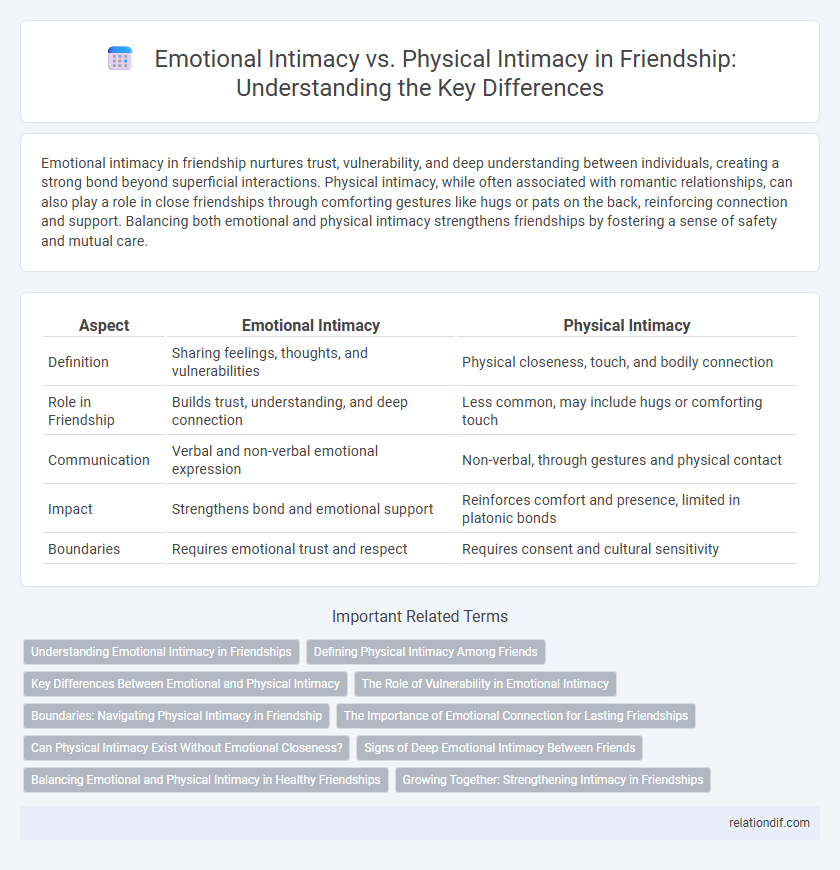Emotional intimacy in friendship nurtures trust, vulnerability, and deep understanding between individuals, creating a strong bond beyond superficial interactions. Physical intimacy, while often associated with romantic relationships, can also play a role in close friendships through comforting gestures like hugs or pats on the back, reinforcing connection and support. Balancing both emotional and physical intimacy strengthens friendships by fostering a sense of safety and mutual care.
Table of Comparison
| Aspect | Emotional Intimacy | Physical Intimacy |
|---|---|---|
| Definition | Sharing feelings, thoughts, and vulnerabilities | Physical closeness, touch, and bodily connection |
| Role in Friendship | Builds trust, understanding, and deep connection | Less common, may include hugs or comforting touch |
| Communication | Verbal and non-verbal emotional expression | Non-verbal, through gestures and physical contact |
| Impact | Strengthens bond and emotional support | Reinforces comfort and presence, limited in platonic bonds |
| Boundaries | Requires emotional trust and respect | Requires consent and cultural sensitivity |
Understanding Emotional Intimacy in Friendships
Emotional intimacy in friendships involves sharing personal thoughts, feelings, and experiences, fostering trust and deep connection beyond physical presence. Unlike physical intimacy, which relates to bodily closeness and touch, emotional intimacy strengthens bonds through empathy, active listening, and mutual support. Cultivating this form of closeness enhances friendship resilience and promotes mental well-being by creating a safe space for vulnerability.
Defining Physical Intimacy Among Friends
Physical intimacy among friends involves non-sexual touch such as hugging, holding hands, or casual pats on the back that convey comfort and trust. This form of closeness strengthens emotional bonds by providing reassurance and a sense of safety without romantic implications. Establishing clear boundaries in physical intimacy helps maintain mutual respect and prevents misunderstandings within the friendship.
Key Differences Between Emotional and Physical Intimacy
Emotional intimacy involves sharing personal feelings, thoughts, and vulnerabilities, fostering a deep sense of trust and understanding in a friendship. Physical intimacy, on the other hand, centers on physical closeness and touch, such as hugging or holding hands, which can strengthen bonds but does not necessarily involve emotional depth. The key difference lies in emotional intimacy's emphasis on psychological connection, while physical intimacy emphasizes bodily connection, both playing distinct roles in developing and maintaining friendships.
The Role of Vulnerability in Emotional Intimacy
Vulnerability plays a crucial role in emotional intimacy by allowing individuals to share their deepest fears, hopes, and experiences without fear of judgment, fostering trust and genuine connection. Unlike physical intimacy, which primarily involves bodily closeness, emotional intimacy thrives on open communication and empathetic understanding between friends. This deep vulnerability strengthens bonds and creates a safe space for authentic emotional expression.
Boundaries: Navigating Physical Intimacy in Friendship
Emotional intimacy in friendship builds trust and deep understanding, while physical intimacy requires clear boundaries to maintain comfort and respect. Navigating physical intimacy involves open communication about personal limits and mutual consent to prevent misunderstandings. Establishing these boundaries strengthens the friendship by preserving emotional safety and fostering genuine connection.
The Importance of Emotional Connection for Lasting Friendships
Emotional intimacy forms the foundation of lasting friendships by fostering trust, empathy, and mutual understanding beyond physical interactions. Deep emotional connections enable friends to share vulnerabilities and support each other through life's challenges, strengthening the bond over time. Prioritizing emotional closeness ensures friendships endure changes in physical proximity or circumstances, maintaining resilience and meaningful interaction.
Can Physical Intimacy Exist Without Emotional Closeness?
Physical intimacy without emotional closeness can occur in various relationships but often lacks the depth and trust found in emotionally intimate connections. Emotional intimacy fosters vulnerability and understanding, creating a foundation for physical closeness to feel meaningful and fulfilling. Research shows that relationships combining emotional and physical intimacy typically experience higher satisfaction and stability compared to those relying solely on physical aspects.
Signs of Deep Emotional Intimacy Between Friends
Deep emotional intimacy between friends is marked by unwavering trust, open vulnerability, and empathy that fosters a safe space for sharing fears and dreams. Signs include frequent, meaningful conversations where both parties actively listen and respond with genuine care. Consistent support during personal challenges and celebrations further underscores a strong emotional bond beyond physical presence.
Balancing Emotional and Physical Intimacy in Healthy Friendships
Balancing emotional and physical intimacy in healthy friendships requires recognizing the unique value each form of closeness brings to the relationship. Emotional intimacy fosters trust, vulnerability, and deeper understanding, while physical intimacy, such as hugs or casual touch, can reinforce connection and comfort. Maintaining clear communication and respecting boundaries ensures both forms of intimacy enhance friendship without overstepping personal limits.
Growing Together: Strengthening Intimacy in Friendships
Emotional intimacy in friendships involves sharing feelings, thoughts, and vulnerabilities that foster trust and understanding, while physical intimacy may include gestures like hugs or comforting touches that reinforce connection. Growing together through open communication, empathy, and shared experiences strengthens both emotional and physical intimacy, creating a resilient bond. Prioritizing emotional closeness with supportive actions deepens friendship intimacy over time, enhancing mutual growth and lasting connection.
Emotional intimacy vs physical intimacy Infographic

 relationdif.com
relationdif.com